千年齐风鲁韵 醉美山东古城
古城,一般是指历史文化名城,拥有百年以上历史至今仍保存完好,或经修缮基本恢复原貌的古建筑城市聚落。古城之美,美在内涵、美在沧桑、美在韵致、美在古朴,蕴含着史学、美学、哲学、以及文学的意味。踏进古城,你会感受一种扑面而来的历史气息,体会一种恍若隔世的生活厚度。山东的古城,或山清水秀,或人文锦绣。这里,民风古朴、民俗典雅,街道错落有致、建筑清秀灵逸,是广大游客观光旅游,休闲度假,学者考古研究的理想之地。山东比较有代表性的古城主要有:青州古城、台儿庄古城、即墨古城、周村古商城、牟氏庄园、南阳古镇、魏集古村落等。
The term “ancient town” in China usually refers to famous towns whose culture and roots go back at least 100 (and sometimes thousands of) years and which are still in good condition or have been restored. The beauty of these towns lies in what they embody, the changes they have undergone, and their charm and simplicity. They are a manifestation of history, aesthetics, philosophy, and literature. Upon entering these towns, you are immediately hit by the sense of history, as if you have been taken back in time. Moreover, they are surrounded by radiant mountains and rivers and brimming with spectacular culture. Here, people live in a refined simplicity. The crisscrossed streets and beautiful architecture make them a paradise for tourists and researchers alike. The most iconic of these towns in Shandong are Qingzhou, Tai’erzhuang, Jimo, Zhoucun, the Mou Family Manor, Nanyang, and Weiji.
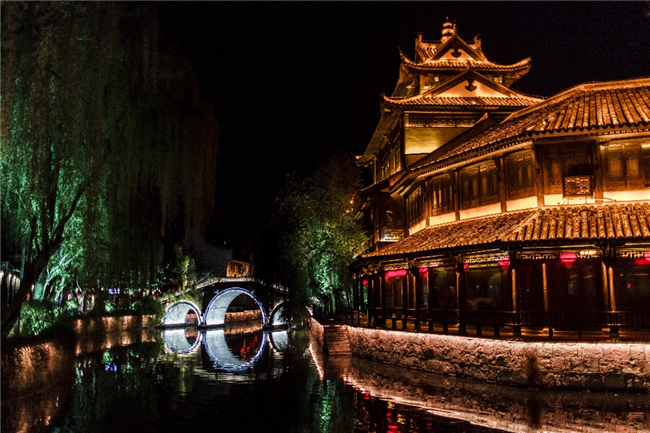
台儿庄古城
台儿庄古城,位于京杭大运河的中心点,坐落于山东省枣庄市台儿庄区,位于鲁苏豫皖四省交界地带。古城肇始于秦汉,发展于唐宋,繁荣于明清,有“天下第一庄”之称(清乾隆赐)。台儿庄古城,被世界旅游组织称为“活着的古运河”“京杭运河仅存的遗产村庄”。台儿庄古城内有古河道、古码头、中华古水城等,是中国国内规模最大的古城。台儿庄古城拥有北方大院、徽派、水乡、闽南、欧式、岭南、鲁南民居等八种建筑风格,为国家5A级旅游景区,有“中国最美水乡”之誉。台儿庄既是民族精神的象征、历史的丰碑,也是大运河文化的承载体。
Tai’erzhuang Ancient Town
Tai’erzhuang Ancient Town is located at the center of the Grand Canal in Tai’erzhuang District, Zaozhuang City, which is where the four provinces of Shandong, Jiangsu, Anhui, and Henan meet. It was built during the Qin (221 – 206 BCE) and Han (206 BCE – 220 CE) dynasties, saw development during the Tang (618 – 907) and Song (960 – 1279) dynasties, and flourished during the Ming (1368 – 1644) and Qing (1644 – 1911) dynasties. The Qianlong Emperor of the Qing dynasty hailed is as the “the world’s first town,” and the World Tourism Organization has called it the “the last living section of the old Grand Canal” and the “last remaining heritage village along the Grand Canal.” In the town are ancient waterways and docks (hence the town also being known as the “ancient water town of China”), and a Cross-Strait Exchange Base.It is China’s largest ancient town, and its buildings represent eight architectural styles: northern courtyard, Huizhou, water town, Minnan, European, Lingnan, and southern Shandong. Further known as “China’s most beautiful water town,” it is a nationally designated 5A scenic area, a symbol of the spirit of the Chinese people, a monument to history, and a vehicle of the Grand Canal culture.
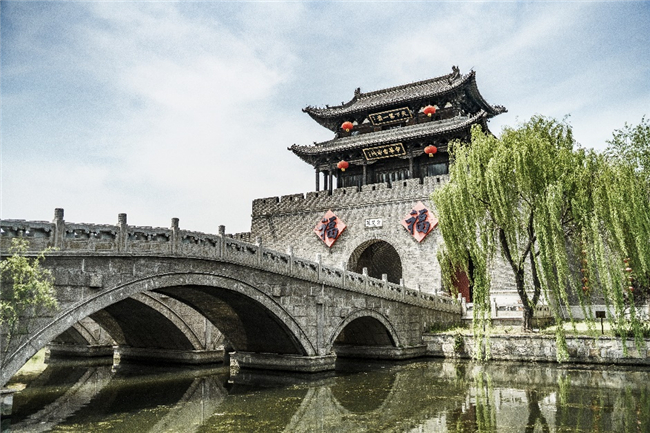
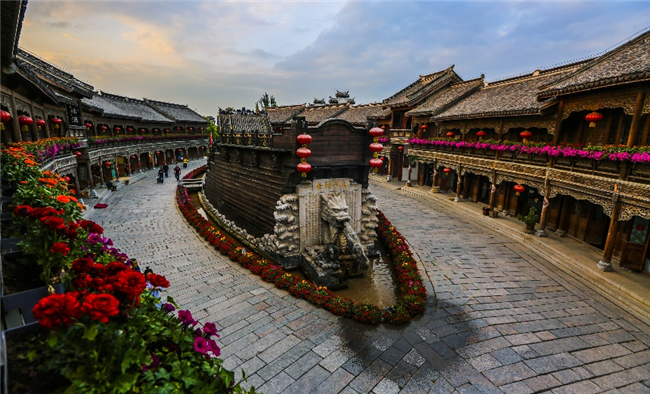
青州古城
青州位居齐鲁大地的腹地,山东半岛的咽喉处,是山东东部的交通枢纽。远古时期,大禹治水,改堵为疏,把全国划分为九州(冀、兖、青、徐、梁、扬、雍、豫、荆),青州即为古九州之一。中国古代的五行学说认为,青州位于最东方,东方属木,木色为青,所以称之为青州。青州有欧阳修山斋和李清照纪念馆,在这里游览,即可于经丘寻壑之中,感受一代文豪欧阳修“偷得青州一岁闲,四时终日对潺湲”的小确幸;亦可在闲庭信步中,触及词国女皇李清照“甘心老是乡矣”的理想愿景。
Qingzhou Ancient Town
Qingzhou, in the interior of Shandong, or more precisely, in the “throat” of the Shandong Peninsula, is a transportation hub in the eastern part of the province. Long ago when Yu the Great controlled the waters, changing the strategy of trying to block excess water to one of allowing it to flow freely away, he divided the nation into nine provinces, Qingzhou being one of them (the others were Ji, Yan, Xu, Liang, Yang, Yong, Yu, and Jing). In ancient China’s theory of the five elements, east is represented by wood. Since Qingzhou is in the east, it was equated with wood, and since the color of some wood is dark green (“qing” in Chinese), the province was thus named. The Ouyang Xiu Mountain Study Room (which belonged to the greater writer Ouyang Xiu) and Li Qingzhao Memorial Hall (dedicated to the great female poet Li Qingzhao) are there. While visiting these two places, you can wander among hills and through valleys and experience the bliss described by Ouyang: “Living leisurely in Qingzhou, one may watch water gently flowing all day regardless of the season.” Or, while idly strolling through a courtyard, you can truly understand why Li wrote, “I would love to live here my whole life.”
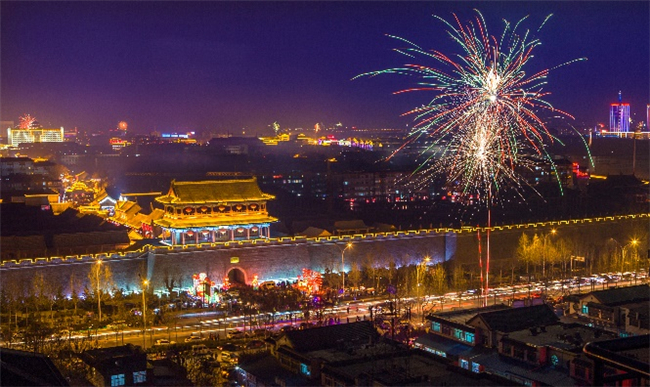
即墨古城
即墨古城位于青岛市即墨区东关街。这里有千年的文化底蕴,是文明遐迩的江北商贸之都;这里有山水相依,泉海相融的奇迹美景。百年青岛,千年即墨,一座起始于《战国策》,辉煌于《史记》的千年古城,“即墨之饶,车毂击,人肩摩”是古城曾经繁华的真实写照。即墨东临翠山碧海,西拥千顷良田,气候温和,资源丰富,交通发达。从古至今,一个个传诵千古的典故,让即墨昭彰史册。来到这里,一眼就会爱上她,徜徉其中,用心感受沉淀于生活的市井百态,静静欣赏那古朴厚重的建筑风格,侧耳倾听其古韵悠长的民谣曲调,每一处栖息之地,都会让你卸下疲惫,远离烦俗,让心灵回归宁静。
Jimo Ancient Town
Dongguan Street in Jimo District, Qingdao City has a culture that goes far back in time and bustling commerce. It is blessed with the beauty of mountains, rivers, springs, and the ocean. As it is written of in Strategies of the Warring States, we know its history goes back to the Warring States period (475 – 221 BCE), and it flourished during the time of writing of the Records of the Grand Historian. It was said of Jimo that “The flourishing town is always full of people and carts.” To the east are lush mountains and the blue ocean, and to the west are rice fields as far as the eye can see. It has a mild climate, is rich in resources, and boasts a well-developed transportation network. Since ancient times, a number of stories of the town have been recorded in China’s books of the past. As soon as you arrive, you are sure to fall in love with it. While wandering around, do all you can to experience the many facets of the marketplace, quietly enjoy the simple, dignified architecture, and listen carefully to the folk songs from ages past. Every corner of the town will inspire peace and happiness in you, allowing you to completely forget the worries of everyday life.
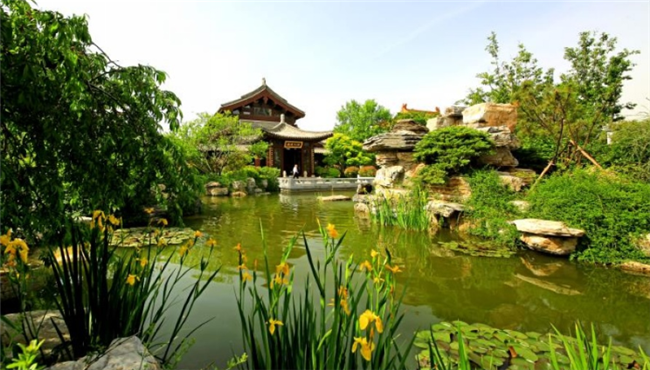
周村古商城
淄博周村素有“天下第一村”“金周村”“旱码头”的美誉,是著名的“儒商发源地”和“丝绸之乡”。周村古商城与其它古城最大的不同是:这里没有水,也没有船。这里的建筑古朴而硬朗,质拙浑厚的商业文化是其工商业发达的重要成因。周村古商城拥有国内罕见、保存完整的5万多平米的明清古建筑群。周村古商城历经数百年风雨,至今仍保存完好,街区纵横、店铺林立,建筑风格迥异,被誉为活着的“古商业街市博物馆群”。这里有千佛寺、状元堂、大染坊等景点,诠释了周村鲁商文化、建筑文化、丝绸文化、民俗文化、宗教文化的历史沿革。历史悠久的饮食文化种类繁多,蜚声海内外的周村烧饼,因产于山东淄博周村而得名,是山东省的著名特产之一,以传统工艺制作而成,有“酥、香、薄、脆”四大特点,入选国家非物质文化遗产名录。
Zhoucun Ancient Town
Zhoucun, located in Zibo City, is known in China as “the world’s first village,” “Golden Zhoucun,” and “the dry dock.” It was also known for its silk and as home to the Confucian merchants. The biggest difference between this town and other ancient towns is that this one has neither boats nor water. The buildings are simple and staunch. Its undecorated honesty is the main reason why business flourished here. The town contains a completely preserved Ming-Qing dynasty architectural complex that covers over 50,000 square meters, which is a rarity. After hundreds of years of ups and downs, the town is still well-preserved. Its streets are neatly arranged at 90-degree angles to each other, full of shops and a variety of architectural styles, hence its being known as a “living museum of ancient commercial marketplaces.” Some of the more notable buildings include the Qianfo Temple, Zhuangyuan Hall, and Dyeing Workshop, which trace the town’s commercial, architectural, silk, folk, and religious history and culture. It also has an old food culture. For example, it is where the world-famous Zhoucun sesame seed cake, one of Shandong’s feature foods, is produced. Made in the traditional way, these cakes (actually more like crackers) are known for being crisp, fragrant, thin, and brittle. They even made it onto China’s list of national intangible cultural heritage.
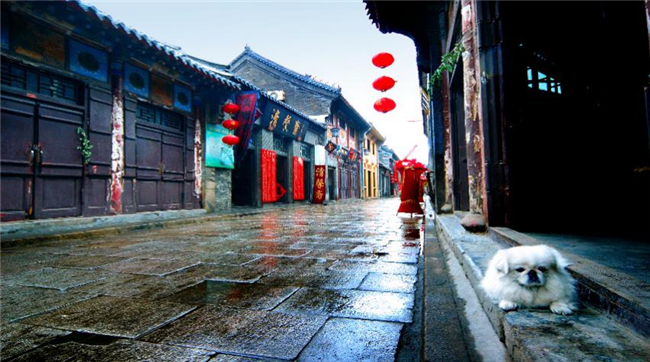
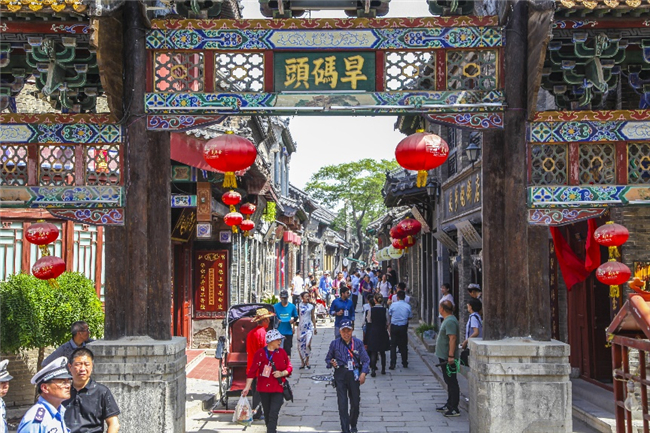
牟氏庄园
牟氏庄园坐落于山东省烟台市栖霞市城北,是牟墨林家族几代人聚族而居的地方。牟氏庄园以其恢宏的规模、深沉的内涵,被诸多专家学者评价为“百年庄园之活化石”“传统建筑之瑰宝”“六百年旺气之所在”。牟氏庄园吸取了中国北方民族建筑艺术风格的优秀建筑成果,具有极高的艺术价值和丰富的历史文化内涵,素有“中国民间小故宫”之称。
Mou Family Manor
The Mou Family Manor is in northern Qixia, Yantai City, Shandong. It is where the family and descendants of Mou Molin lived for generations. The manor is extensively large and full of profound significance, hailed as “a living fossil of manors from over a century ago,” “a gem of traditional architecture,” and “a site of six centuries of prosperity” by numerous experts. The manor manifests the amazing beauty of northern Chinese architecture, thus possessing value artistically, historically, and culturally. It is even known informally as the “Lesser Palace Museum.”
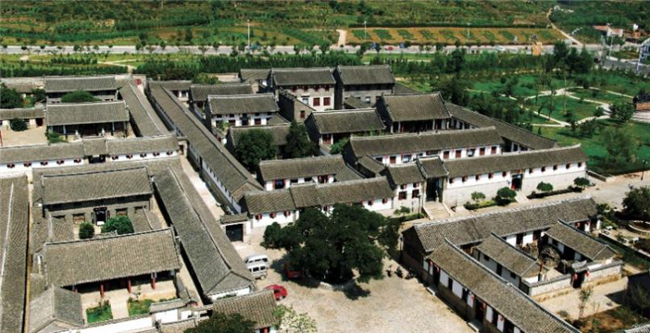
朱墙碧瓦,谁在月下独酌;茶坊酒肆,正把长歌弹拨……
踏着斑驳的石板老街,抚摸一段尘封的辉煌和沧桑;穿越时光,寻找一种千百年的闲适与温情。古城游览,意在现代喧嚣之中寻觅一种温润与恬淡。
每一座古城,都有一座延绵不绝的历史,都有自己独特的性格和韵味。她是一个城市永恒的记忆和载体,如同底蕴深厚的乱世佳人历尽风雨而宠辱不惊。
Among red walls and green tiles, who is it that drinks alone under the moon? In tea houses and taverns, a song begins to be played…
Walking along the mottled stone-slab streets of an ancient town, one can feel the golden age of the past and the changes that have taken place over the centuries. Going back in time, one searches for the quiet and warmth of ages ago, holding total indifference to fame and fortune in the clamor of the modern world.
Each of these towns has a history that goes far back and its own unique character and charm. They are eternal vessels for memories of the past, like great people who stand out in times of chaos, enduring both honor and disdain equally without being moved in the least.

